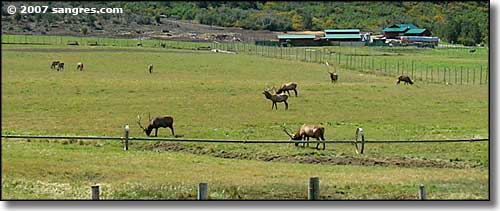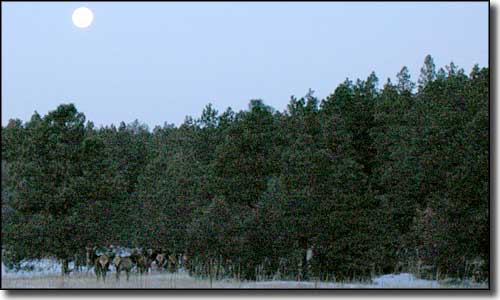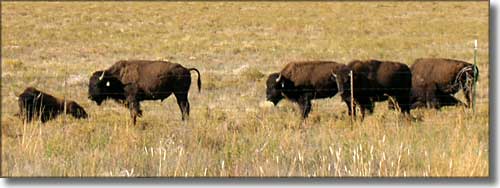 |
|---|
Agricultural Issues - Raising Alternative Livestock |
|
|
 |
|
Elk
Elk have been raised behind wire in North America since the late 1800's. At this point, most privately raised elk have been domesticated for generations. Domesticated elk are the same species as wild elk, they just behave differently. Mature bull elk stand 5 to 5.5 feet at the shoulder and weigh in at 800 to 1,000 pounds. While they are capable of breeding at 2 years old, they mature at 6 to 7 years. The number of points on their antlers is influenced by nutrition and genetics and is used to indicate maturity. Mature elk drop their antlers in March and regrow them every year. Velvet antlers are harvested in May or June and a mature bull should produce 20 to 30 pounds of Grade A velvet. In recent years, Grade A velvet prices have fluctuated between $50 and $100 per pound. Mature cow elk stand 4 to 5 feet at the shoulder and weigh in at 600 to 700 pounds. They may calve as 2-year-olds but they mature at 3 to 4 years. Cow elk do not grow antlers. They generally have a single 30-to-40 pound calf in late May-early June. Calves are born spotted and develop a brown coat by six-months old. Rutting season for elk runs from August to October. Bulls compete for dominance through sparring, bugling and chasing would-be competitors away. Each bull will gahter his own group of females and keep them away from other bulls. One bull can service 20 to 40 cows. Once impregnated, the cow will drop the calf in about 250 days. If you want to ranch elk in Colorado, you'll need to contact both the Department of Agriculture and the Division of Wildlife. Visit numerous elk ranches and look at their animals and their facilities before you buy your first elk. In Colorado, you must have your fence and your handling facilities built prior to receiving a license to own elk. And in Colorado, all elk must come from whole TB tested and genetic purity tested herds. House Bill 94-1096 contains the full details of the regulations on raising domestic elk. |
 The full moon above a herd of elk |
 |
|
Bison
Bison are very social animals that work together as a herd to protect each other against the environment and against predators. They adapt so well to their surroundings that you'll find them being raised all over the world. It's only over the last 30 years that bison have come to be considered truly agricultural ranching and not just a form of hobby ranching. Breeding season is in August and September. The bulls get very aggressive and protective of their herd at this time and can be very dangerous. For that matter, breeding season is the only time to let the bulls and cows get together. At any other time of year, the bulls think the calves are competition and they will charge at them. Bison calves are usually born in late April, early May, and average about 40 pounds at birth. Weighing half what a beef calf weighs, the bison mothers rarely have a problem calving. At birth the calves are a reddish-orange color and change to brown by the time they are 4 to 6 months old. Bison don't tend to be mean but they will take action if they feel threatened. They are curious and may get close to you but don't try to pet one. Particularly dangerous in this are cows with young calves. Very efficient grazers, bison will push through snow to get grass (unlike cattle). They will eat about 90% of what a beef cow eats. Conversion of a cattle operation into a bison operation is not very expensive. Breeders recommend at least five foot fences to keep the bison in, with corrals that appear to be solid-walled and at least seven feet tall. The squeeze chute needs to be one designed for bison as cattle chutes don't work properly for them and their needs are different. While most bison cows have their first calf at three-years-old, they generally live into their thirties and can have calves almost every year. Quality breeding stock is in demand: new herds are being established and existing herds need replacements. Breeders are finding that almost every part of a bison is marketable. With buffalo meat prices about double that of beef and with high demand for by-products, bison can be very profitable. Bison breeding stock brings about the same price as purebred beef cattle. |
|
|
 |
| Index - Arizona - Colorado - Idaho - Montana - Nevada - New Mexico - Utah - Wyoming National Forests - National Parks - Scenic Byways - Ski & Snowboard Areas - BLM Sites Wilderness Areas - National Wildlife Refuges - National Trails - Rural Life Advertise With Us - About This Site - Privacy Policy |
| Photos courtesy of Sangres.com, CCA ShareAlike 3.0 License. Text Copyright © by Sangres.com. All rights reserved. |